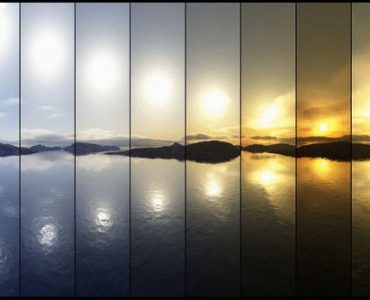Question: Do All the Prayer Times Occur Above 45 Degrees of Latitude - in the Polar Regions?
According to the balance that God has set, in every season dhuhr, asr, maghrib, isha, middle of the night, sahar, imsaq/fajr times are observed everywhere . The middle of the night and sahar comprise the middle of the night, which is the longest part of the night. There is a perfect equilibrium between the regions that are above and below 45 degrees of latitude.

According to the following verse, nights can be sunny, and daytimes can be sunless, though illuminating its surroundings:
وَجَعَلْنَا اللَّيْلَ وَالنَّهَارَ آيَتَيْنِ فَمَحَوْنَا آيَةَ اللَّيْلِ وَجَعَلْنَا آيَةَالنَّهَارِ مُبْصِرَةً لِتَبْتَغُواْ فَضْلاً مِّن رَّبِّكُمْ وَلِتَعْلَمُواْ عَدَدَالسِّنِينَ وَالْحِسَابَ وَكُلَّ شَيْءٍ فَصَّلْنَاهُ تَفْصِيلاً
“We have made the night and the daytime two indicators; then We have eliminated the indicator of the night, and made the indicator of the daytime being illuminating. So that, you may seek the favor of your Master, and know the count of the years and the calculation. We have explained everything in detail.” (Al-Isra 17:12)
When we comply with these criteria, it is seen that the duration of fasting in polar regions is rather short.
There are two verses which begin with the command “keep up the prayer” and explain the times of prayer. The first one is:
وَأَقِمِ الصَّلَاةَ طَرَفَيِ النَّهَارِ وَزُلَفًا مِنَ اللَّيْلِ إِنَّ الْحَسَنَاتِ يُذْهِبْنَ السَّيِّئَاتِ ذَلِكَ ذِكْرَى لِلذَّاكِرِينَ
“Keep up the prayer in two parts of the daytime and in the hours of the zulaf of the night.” (Hud 11:114)
Zulaf (زلف) is the plural form of the word zulfa, which means “closeness”. In Arabic, because the meaning of plural is a minimum of three, the term “the zulaf of the night” means “the periods that are closest to the daytime”. These periods can be distinguished by temperature differences in polar and by regions, and by the twilights in regular regions. In polar regions, daytime is the duration between the emergence and absence of duha, which is the wavy sun light (see Chapter al-Shams).
The evening twilight lasts from the sunset till the appearance of dim stars. The morning twilight begins with the disappearance of dim stars and lasts until the sunrise.
The second verse beginning with the command “keep up the prayer” is as follows:
أَقِمِ الصَّلَاةَ لِدُلُوكِ الشَّمْسِ إِلَى غَسَقِ اللَّيْلِ وَقُرْآنَ الْفَجْرِ إِنَّ قُرْآنَ الْفَجْرِ كَانَ مَشْهُودًا
“Keep up the prayer from the dolook of the sun till the ghasaq of the night, and at the quran of the fajr. The quran of the fajr is visible to the eye.” (Isra 17:78)
Dulook of the sun is the westwards shift of the sun from its zenith. The ghasaq of the night is the middle of the night, which is the period between the periods that are close to the daytime. During ghasaq of the night the weather gets fairly cold.
The quran of the fajr is the fajr time when lights of morning accumulate and create clusters of light, because the meaning the of the word quran is “coming or bringing together”. The last Book of God is called the Quran because it brings the verses together. This clustering can be observed in every season and everywhere on earth.
It is impossible that the calendars which were not prepared in compliance with these and other related verses may be correct.
For details of this work, please see the article:






Add comment